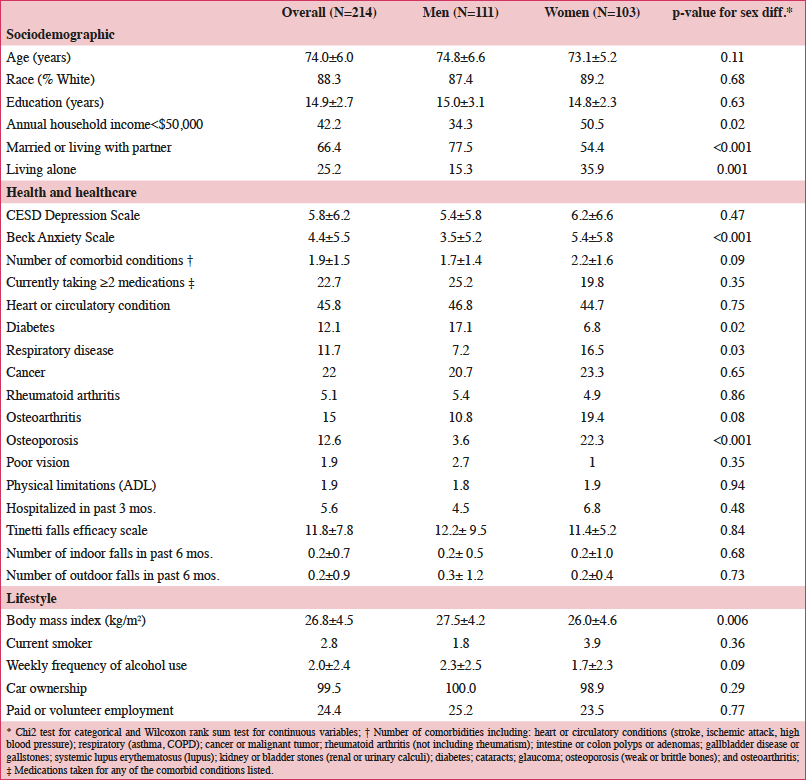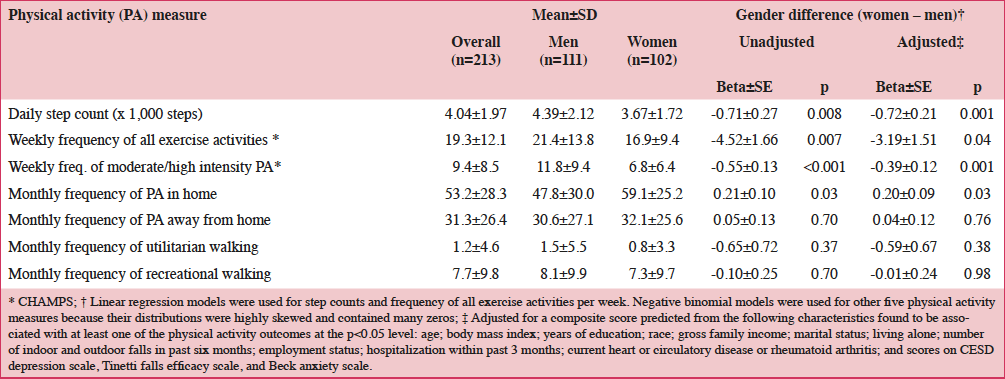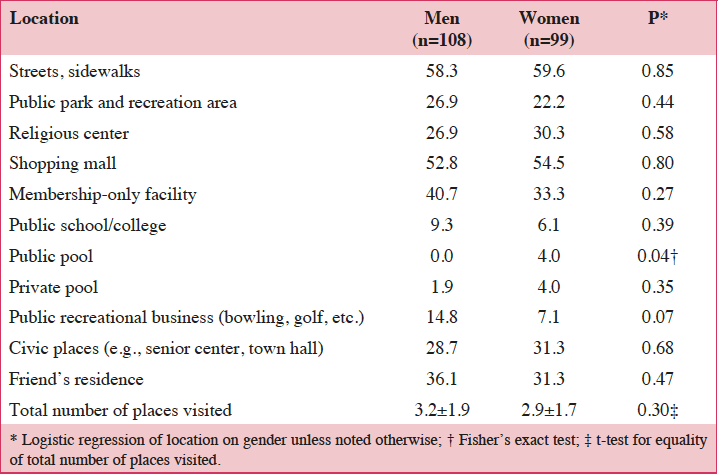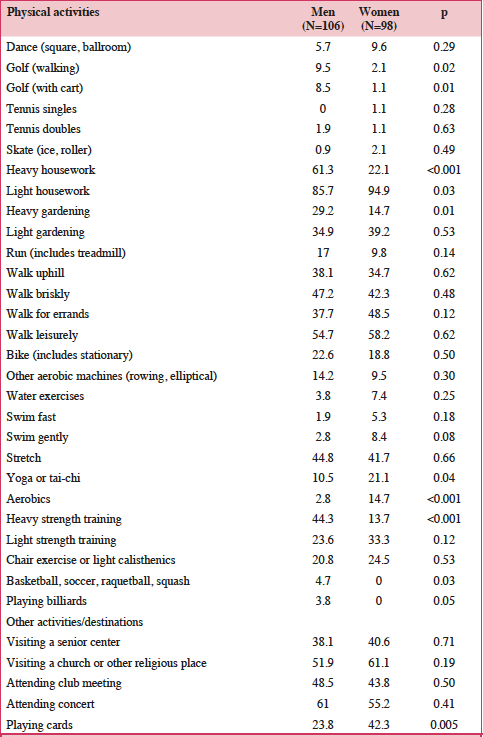W. Li1, E. Procter-Gray1, L. Churchill1, S.E. Crouter2, K. Kane1, J. Tian3, P.D. Franklin4, J.K. Ockene1, J. Gurwitz1
1. Department of Medicine, University of Massachusetts Medical School, 55 Lake Avenue North, Worcester, MA 01655, USA; 2. Department of Kinesiology, Recreation, and Sport Studies, The University of Tennessee Knoxville, 1914 Andy Holt Ave, Knoxville, TN 37996, USA; 3. Department of International Development, Community, and Environment, Clark University, 950 Main Street, Worcester, MA, 01610, USA; 4. Department of Orthopedics and Physical Rehabilitation, University of Massachusetts Medical School, 55 Lake Avenue North, Worcester, MA 01655, USA..
Corresponding author: Wenjun Li, PhD, Associate Professor, Director, Health Statistics and Geography Lab, Division of Preventive and Behavioral Medicine, Departments of Medicine, University of Massachusetts Medical School, School Building S4-314, 55 Lake Avenue North, Worcester, MA 01655, Phone: 774-455-4215 Fax: 508-856-4543, Email: Wenjun.Li@umassmed.edu
Care Weekly 2017;1:7-13
Published online November 9, 2017, http://dx.doi.org/10.14283/cw.2017.4
Please, note that this article was published also in the Journal of Frailty Aging (JFA) http://dx.doi.org/10.14283/jfa.2017.15
Abstract
Background: A thorough understanding of gender differences in physical activity is critical to effective promotion of active living in older adults. Objectives: To examine gender and age differences in levels, types and locations of physical activity. Design: Cross-sectional observation. Setting: Car-dependent urban and rural neighborhoods in Worcester County, Massachusetts, USA. Participants: 111 men and 103 women aged 65 years and older. Measurements: From 2012 to 2014, participants were queried on type, frequency and location of physical activity. Participants wore an accelerometer for 7 consecutive days. Results: Compared to women, men had a higher mean daily step count (mean (SD) 4385 (2122) men vs. 3671(1723) women, p=0.008). Men reported higher frequencies of any physical activity and moderate-to-vigorous physical activity, and a lower frequency of physical activity inside the home. Mean daily step counts and frequency of physical activity outside the home decreased progressively with age for both men and women. Women had a sharper decline in frequencies of self-reported physical activity. Men had a significant decrease in utilitarian walking, which women did not (p=0.07). Among participants who reported participation in any physical activity (n=190), more women indicated exercising indoors more often (59% vs. 44%, p=0.04). The three most commonly cited locations for physical activity away from home for both genders were streets or sidewalks, shopping malls, and membership-only facilities (e.g., YMCA or YWCA). The most common types of physical activity, performed at least once in a typical month, with over 40% of both genders reporting, included light housework, brisk walking, leisurely walking, and stretching. Conclusion: Levels, types and location preferences of physical activity differed substantially by gender. Levels of physical activity decreased progressively with age, with greater decline among women. Consideration of these gender differences is necessary to improve the effectiveness of active living promotion programs among older adults.
Key words: Gender, physical activity, type, location, aging.
Introduction
Adequate levels and proper type of physical activity are critical for the prevention of chronic diseases and disabilities among older adults (1-3). Moderate physical activity, such as walking, has been widely recommended by the Centers for Disease Control and Prevention (CDC) and health professionals for older adults as a means of reducing risk for chronic conditions and disabilities (4, 5). Older men and women differ in a number of socioeconomic (e.g., education, family income, culture, social norms) and biological factors that influence health behaviors. A better understanding of gender differences in the patterns and determinants of physical activity behaviors may shed light on the design of active living promotion programs that address the specific needs of both genders.
Although personal determinants of physical activity are well documented in the literature, less is known about the adaptation to and use of residential environments among older adults. Several built environment factors have been associated with type and level of adult physical activity (6-8) including low population density in suburbs (9), car dependency (10), proximity to shops and health care facilities (11), lack of access to fitness facilities (12), lower “walkability” (13), limited access to public parks and recreational areas (14), availability and conditions of sidewalks or walkways in neighborhoods (15, 16), and opportunities to make utilitarian walking trips from home (17). Older adults may have more physical limitations and no longer routinely travel outside their neighborhoods to work. Therefore, their daily living, health, and well-being may depend more on neighborhood resources in close proximity to their homes. Compromised mobility and reduced income and ability to drive limit their use of fitness facilities. Therefore, access or proximity to resources critical for healthy aging may influence aging in various aspects. In this study, we investigated gender differences in mobility patterns and levels, types and location of physical activity. Findings from this analysis may have important implications for healthy aging promotion.
Methods
Study area
According to the American Community Survey of 2015, Worcester County, including the City of Worcester, is a metropolitan area in Central Massachusetts, with a population of approximately 680,000 in 2015. The county includes a mix of urban, suburban and rural neighborhoods. The area is highly car-dependent and has infrequent bus services limited to the City of Worcester. Among workers 16 years and over living in households, 96.4% have access to at least one motor vehicle.
Recruitment of participants
Community-dwelling older adults were recruited in the study area. To increase the diversity and representativeness of the study sample, an “area-based” strategy was used for recruitment and oversampling of participants living in rural neighborhoods. Participants were recruited through presentations at community organization meetings, distribution of flyers, and direct mail. Promotional materials, interest surveys and brief presentations were offered at each venue and tailored to meet site preferences. To promote the study, venues included senior centers, veteran’s organizations, and men’s breakfasts at retirement villages. The opportunity to participate was offered, asking those who were interested to complete a form for further contact. In addition, flyers were distributed at the public housing authority, health clubs and at health fairs. Names, home addresses, phone numbers, and email addresses (if available) of potential participants were obtained through the above-mentioned venues as well as through the University of Massachusetts Medical School (UMMS) Centers for Clinical and Translational Science Conquering Diseases database. Letters and interest surveys were mailed to randomly selected addresses in rural, suburban and urban zip codes. Once a prospective participant expressed interest, the program director or designee contacted the person, explained the study, determined eligibility, and mailed the prospective participant a consent form.
To be eligible for the study, individuals had to be aged 65 years or older, able to provide consent, English speaking, ambulatory with or without assistive devices, willing and able to perform all study-related activities independently or with a designated caregiver, and pass cognitive function screening with 3 or fewer errors on the Short Portable Mental Status Questionnaire (18).
The consent form was reviewed with the prospective participant. Once consented, a baseline visit was scheduled for each participant. Multiple methods of participation were offered, including a one-on-one visit with a study team member at UMMS, at a Senior Center, or at their home, according to participant preferences and needs.
Surveys completed at home were returned by mail using a study-provided pre-paid envelope. Each participant completed two batteries of survey instruments, which took about 2-3 hours. The first battery included surveys to assess sociodemographics, health and health care, lifestyle factors, anxiety, lower extremity problems, and fall history and falls efficacy. In the week following the completion of the first battery, participants wore an accelerometer and Global Positioning System device for 7 consecutive days and completed dietary intake measures including 3 24-hour recalls of dietary intake within the 7 days. The second battery included instruments measuring physical activity, activity time and place, and depression. Self-reported weight and height were recorded and used to calculate participant body mass index.
The study protocol was approved by the University of Massachusetts Medical School Institute Review Board (Docket #: H-14793).
Personal data
Each participant was queried about their sociodemographic characteristics, physical and mental health conditions, lower extremity symptoms and problems, history of falls and fall injuries, health care utilization in the past year, and lifestyle behaviors itemized in Table 1. Assessment of most characteristics was by self-report using survey questionnaires designed by this study, along with a number of standardized instruments including the Tinetti Falls Efficacy Scale for fear of falling (19), Beck Anxiety Inventory,(20) CES-D Depression Scale (21), and the Short Portable Mental Status Questionnaire for cognitive impairment (18), and Activities of Daily Living for physical limitations.
Measurement of physical activity
Physical activity was measured objectively with an accelerometer (ActiGraph GT3X-Plus) worn by each participant during all waking hours for 7 consecutive days. A daily mean number of steps was calculated for each person, excluding any non-wearing days.
Self-reported measures of physical activity were assessed through the Community Healthy Activities Model Program for Seniors (CHAMPS) survey of frequency of exercise activities, both recreational and functional.(22, 23) Measures included 1) frequency of all exercise activities; frequency of moderate-to-high-intensity exercise; 3) frequency of performing physical activities in the home; 4) frequency of performing physical activities away from home; 5) frequency of walking for utilitarian purposes (e.g., walk to a food store in neighborhood); and 6) frequency of walking for recreational purposes (i.e., walk for at least 10 minutes for exercise in neighborhood).
To investigate differences in preferences for place of physical activity, participants were asked, “When performing physical activities away from home, do you usually do them indoors or outdoors?» Participants also were asked to choose from a list of 11 locations at which they perform physical activity at least once a month.
Statistical analysis
Participant characteristics were summarized by gender. Gender differences in sociodemographic, physical and mental health, and lifestyle factors were evaluated using Chi-squared tests for percentages or Wilcoxon rank-sum tests for continuous variables.
Gender differences in 7 physical activity measures were examined using regression models. For mean daily step count and CHAMPS frequency of all exercise activities, linear regression models were used. For the other 5 self-report physical activity measures that had skewed distributions, negative binomial regression models were used. The coefficients for female versus male gender were reported with and without covariate adjustment (see list of covariates in Table 2 footnote). To preserve degrees of freedom when adjusting for multiple covariates, a single composite adjustment score was derived for each outcome for each person using the entire set of adjusting factors as predictors in regression models. Each person’s composite score was then predicted as the sum of all the products of each specific regression coefficient multiplied by his/her value of the corresponding characteristic.(24) The composite score was used in the regression models to obtain covariate-adjusted coefficients for gender differences. Finally, gender differences in preferences for type and location of physical activity were tested using logistic regression models.
Results
Participants included 111 men and 103 women, 88% White, and had mean (SD) age of 74 (6) years, and a mean of 15 years of education (Table 1). Compared to men, more women had an annual income <$50,000 (p=0.02) and lived alone (p=0.001). Women also reported a higher degree of anxiety and a higher prevalence of respiratory disease and osteoporosis. A greater proportion of men had diabetes, and men had a slightly higher mean body mass index.

As shown in Table 2, average daily step counts were approximately 16% higher for men than for women (p=0.008). Self-reported frequencies of all exercise activities and of moderate-to-vigorous intensity exercise activities also were significantly higher for men than women. However, women reported a higher frequency of physical activity inside the home. Adjustment for personal characteristics decreased the magnitude of the gender difference in physical activity frequencies by approximately 29%, although all differences remained statistically significant.

Frequencies of physical activity away from home or for utilitarian and recreational walking did not notably differ by gender. It may be noted that utilitarian walking was very infrequent on average in this largely car-dependent population, with a mean frequency of 1.2 times per month.
As shown in Table 3, all 7 physical activity measures decreased with age when data from men and women are combined; significantly so for mean daily step counts and frequency of performing physical activity outside the home. Women showed a somewhat sharper decrease in frequencies of self-reported activities than did men, and men had a significant decrease in utilitarian walking, while women did not.

Associations of physical activity measures with advancing age (5-year increase)
Among 190 participants who reported participation in any physical activity, 59% of women and 44% of men indicated exercising indoors more often (p=0.04), whereas 22% of women and 30% of men reported exercising outdoors more often (p=0.22). About 27% of men and 20% of women reported approximately equal frequencies for exercising indoors versus outdoors. The three most commonly cited locations for physical activity away from home for both genders were streets or sidewalks, shopping malls, and membership-only facilities (e.g., YMCA/YWCA, gym, yoga, martial arts). Substantial proportions of men and women visited religious centers, and civic places (e.g., senior center, town hall) (Table 4).

Self-reported location for performing physical activity at least once per month by gender (percent or mean±SD)
Based on the CHAMPS survey, in a typical month men were more likely than women to participate in golfing, heavy housework (e.g., washing windows, cleaning gutters), heavy gardening (e.g., shoveling, raking), and moderate-heavy strength training (Table 5). Activities more likely to be chosen by women were light housework (e.g., dusting, sweeping), yoga/tai-chi, and aerobic dance. The most common types of physical activity, performed at least once in a typical month, with over 40% of both genders reporting, were light housework, brisk walking, leisurely walking, and stretching.

Percentages of men and women reporting that they would typically participate in the activity listed at least once in the past month
Discussion
Gender differences in health and health behaviors have received greater attention in recent years. A recent policy of the US National Institutes of Health (NIH) requires inclusion of sex/gender in study design to improve the scientific rigor of NIH-funded studies. Gender differences in amount of physical activity have been reported in many previous studies of older adults. However, the type, location and influential factors on physical activity remain poorly understood. This study contributes to the literature new data on gender differences in physical activity among older adults living in car-dependent urban and rural neighborhoods. To our knowledge, these gender differences have not been well documented in the literature, and should be carefully investigated to improve strategies for promoting active living in older populations.
This study observed that both objectively-measured and self-reported physical activity levels and frequencies were significantly higher among older men than women. Older men had higher levels and greater frequency of moderate-to-vigorous intensity physical activity, and higher frequency of exercising outside the home. Both levels and frequencies of physical activity decreased with age, especially for daily step counts and frequency of performing physical activity outside the home. Women had a faster decline in frequencies of self-reported activities. The data suggested the progressive decline in frequency as well as time going outdoors in both genders.
With respect to preferences of indoor and outdoor exercise locations, men and women also differed substantially. About 59% of women and 44% of men reported exercising indoors more often than outdoors. About 56% of men reported exercising outdoors more often or as often as indoors. The data indicated a greater importance of places to do outdoor exercise for older men. The data also confirmed the importance of public indoor and outdoor places for exercises for both men and women, that is, both streets or sidewalks and shopping malls are reported as the most frequent exercise places away from home. While a relatively high proportion of participants used membership-only facilities, substantial proportions of men and women visited other public indoor places such as religious centers, and civic places (e.g., senior center, town hall). The data highlight the importance of these public indoor and outdoor places for promoting active living in older age.
This study has several strengths as well as limitations worth noting. First, an area-based sampling and recruitment strategy was used to ensure both geographic and socioeconomic representativeness of the participants. We successfully recruited participants living in rural and urban neighborhoods with varied housing density. Participant physical activity was measured using both CHAMPS (self-report) and an accelerometer. Location preference of physical activity also was measured using a structured questionnaire. The combinations of these data allowed the study to examine gender differences in patterns as well as determinants of physical activity, including types, location, personal and environmental factors influencing physical activity behaviors and location preferences. Such integrated analyses yield fresh data about this older population that have not been reported in the literature. However, our study was limited in its relatively small size, single geographic location, and cross-sectional nature. Except for the global positioning system and accelerometer data, the study relied on self-report data which are subject to recall and social desirability bias. The study sample was relatively healthy, affluent and well educated. To better understand neighborhood impact on physical activity in older age, a larger and more diverse sample, especially including participants with physical limitations and multiple chronic diseases, is necessary. Our future studies will address these issues.
In conclusion, levels, types and locations of physical activity differed substantially between older men and women living in car-dependent rural as well as urban neighborhoods. Further investigation of the mechanisms of these gender differences is necessary. Careful consideration of these differences may improve healthy aging promotion programs, ensuring that the programs are applicable to both genders.
Conflict of Interest
All authors declare no conflict of interest.
Acknowledgement
This project was supported in part by a Life Science Moment Fund Award (PI: Li) of University of Massachusetts Center for Clinical and Translational Sciences which is funded by the National Center for Advancing Translational Sciences, National Institutes of Health, through Grant UL1TR000161. Several instruments used in this project were created in a pilot study (PI: Li) supported by NIH-funded Women’s Health Initiative (HHSN268201100001C). The content is solely the responsibility of the authors and does not necessarily represent the official views of the NIH.
References
1. Mozaffarian D, Fried LP, Burke GL, Fitzpatrick A, Siscovick DS. Lifestyles of older adults: can we influence cardiovascular risk in older adults? Am J Geriatr Cardiol 2004;13:153-60.
2. Siscovick DS, Fried L, Mittelmark M, Rutan G, Bild D, O’Leary DH. Exercise intensity and subclinical cardiovascular disease in the elderly. The Cardiovascular Health Study. Am J Epidemiol 1997;145:977-86.
3. The Diabetes Prevention Program Research Group. The Diabetes Prevention Program: baseline characteristics of the randomized cohort. The Diabetes Prevention Program Research Group. Diabetes Care 2000;23:1619-29.
4. Vallbona C, Baker SB. Physical fitness prospects in the elderly. Arch Phys Med Rehabil 1984;65:194-200.
5. Melzer I, Benjuya N, Kaplanski J. Effects of regular walking on postural stability in the elderly. Gerontology 2003;49:240-245.
6. King AC, Castro C, Wilcox S, Eyler AA, Sallis JF, Brownson RC. Personal and environmental factors associated with physical inactivity among different racial-ethnic groups of U.S. middle-aged and older-aged women. Health Psychol 2000;19:354-64.
7. Humpel N, Owen N, Leslie E. Environmental factors associated with adults’ participation in physical activity: a review. Am J Prev Med 2002;22:188-99.
8. van Lenthe FJ, Brug J, Mackenbach JP. Neighbourhood inequalities in physical inactivity: the role of neighbourhood attractiveness, proximity to local facilities and safety in the Netherlands. Soc Sci Med 2005;60:763-75.
9. Frank LD. Land Use and Transportation Interaction: Implications on Public Health and Quality of Life. J Planning Educ Res 2000;20:6-22.
10. Lopez-Zetina J, Lee H, Friis R. The link between obesity and the built environment. Evidence from an ecological analysis of obesity and vehicle miles of travel in California. Health Place 2006;12:656-64.
11. Ogilvie D, Mitchell R, Mutrie N, Petticrew M, Platt S. Perceived characteristics of the environment associated with active travel: development and testing of a new scale. Int J Behav Nutr Phys Act 2008;5:32.
12. Blanchard CM, McGannon KR, Spence JC, et al. Social ecological correlates of physical activity in normal weight, overweight, and obese individuals. Int J Obes (Lond) 2005;29:720-6.
13. Saelens BE, Sallis JF, Black JB, Chen D. Neighborhood-based differences in physical activity: an environment scale evaluation. Am J Public Health 2003;93:1552-8.
14. Weiss CC, Purciel M, Bader M, et al. Reconsidering access: park facilities and neighborhood disamenities in new york city. J Urban Health 2011;88:297-310.
15. Cervero R, Duncan M. Walking, bicycling, and urban landscapes: evidence from the San Francisco Bay Area. Am J Public Health 2003;93:1478-83.
16. Frank LD, Schmid TL, Sallis JF, Chapman J, Saelens BE. Linking objectively measured physical activity with objectively measured urban form: findings from SMARTRAQ. Am J Prev Med 2005;28(2 Suppl 2):117-25.
17. King WC, Brach JS, Belle S, Killingsworth R, Fenton M, Kriska AM. The relationship between convenience of destinations and walking levels in older women. Am J Health Promot 2003;18:74-82.
18. Pfeiffer E. A short portable mental status questionnaire for the assessment of organic brain deficit in elderly patients. J Am Geriatr Soc 1975;23:433-41.
19. Tinetti ME, Mendes de Leon CF, Doucette JT, Baker DI. Fear of falling and fall-related efficacy in relationship to functioning among community-living elders. J Gerontol 1994;49:M140-7.
20. Beck AT, Epstein N, Brown G, Steer RA. An inventory for measuring clinical anxiety: psychometric properties. J Consult Clin Psychol 1988;56:893-7.
21. Radloff LS. The CES-D scale: A self report depression scale for research in the general population. Appl Psychol Meas 1977;1:385-401.
22. Cyarto EV, Marshall AL, Dickinson RK, Brown WJ. Measurement properties of the CHAMPS physical activity questionnaire in a sample of older Australians. J Sci Med Sport 2006;9:319-26.
23. Stewart AL, Mills KM, Sepsis PG, et al. Evaluation of CHAMPS, a physical activity promotion program for older adults. Ann Behav Med 1997;19:353-61.
24. Li W, Procter-Gray E, Lipsitz L, et al. Utilitarian walking, neighborhood environment and risk for outdoor falls among older adults. . Am J Public Health 2014;104:e30-7.
